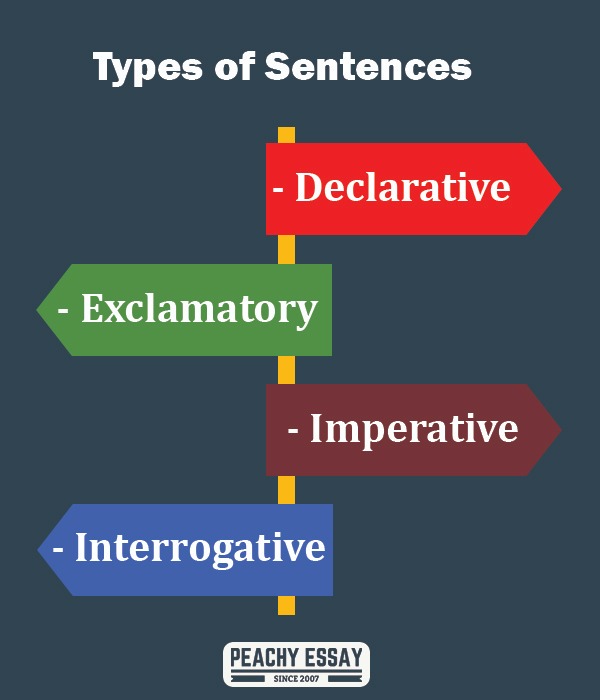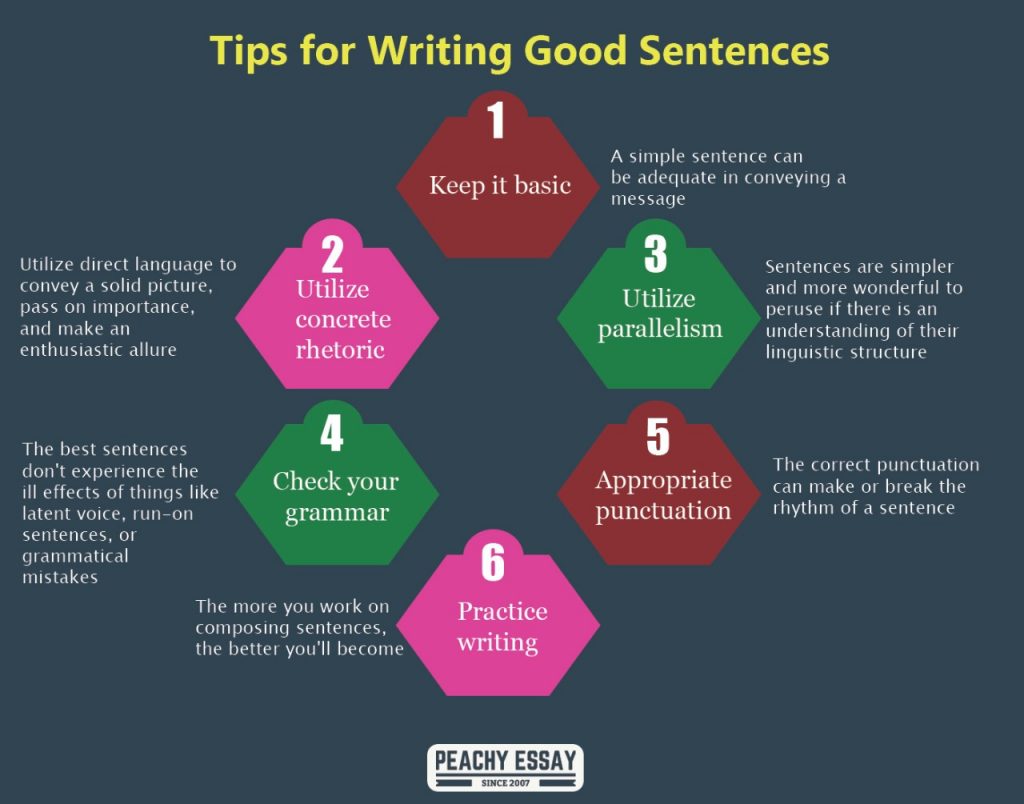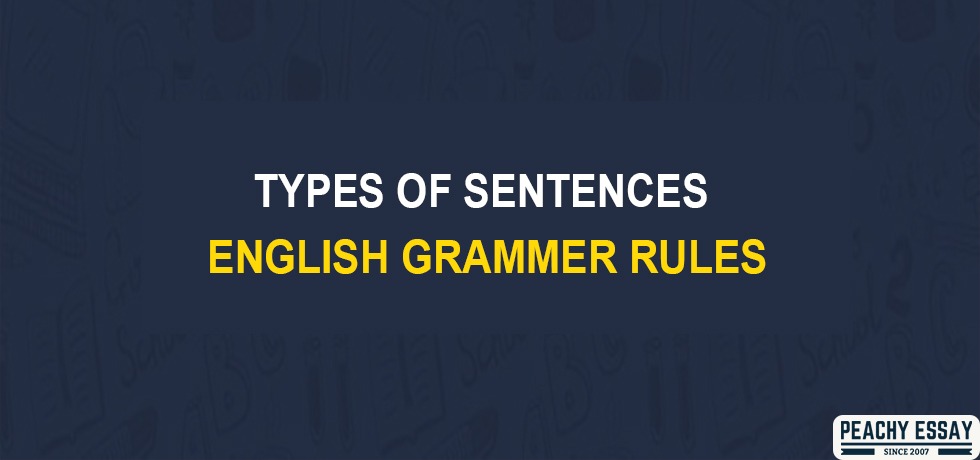There are several sentences you may run over day by day, and every one of them can be ordered into 4 sorts: declarative, interrogative, imperative, and exclamatory; each with its own particular reason. Punctuation likewise assumes a function in separating between these sorts.
Let us comprehend the types of sentences.

Declarative sentences
As the name suggests, a declarative sentence basically declares an assertion or a sentiment. A declarative sentence has an unbiased tone, which means it closes with a period mark “.” The principle objective of this sort of sentence is to say something. Thus, more or less, any sentence that reveals to us something can be credited to this classification. It doesn’t make a difference what sort of data it conveys, regardless of whether it is a proven fact or a hypothetical assertion, the main thing that matters is in the event that it declares something – If it does, it is a declarative sentence.
A couple of instances of declarative sentences:
- I live at 24, East road.
- I like frozen yogurt.
- The breeze is blowing from the west.
Notice how both these sentences pronounce a few emotions; however, not exceptionally solid sentiments, emotions like ” I totally love frozen yogurt!”. This sentence turns into an exclamatory sentence finishing off with the shout mark – “!”
Exclamatory sentences
As the name proposes, exclamatory sentences express solid sentiments and fervor or extraordinary abhorrence. These sentences are very noisy, as in they clarify full feelings. It is utilized to communicate a solid astonishment of feeling and consistently finishes with an exclamation mark.
These are announcements simply like declarative sentences, but with a lot more grounded feelings. That is the reason they end in the exclamation mark.
Examples:
- Goodness, she should adore scuba jumping!
- Red ocean blue openings are incredible!
- I can’t really accept that she ran that quickly to snatch the bone!
Imperative sentences
At whatever point interest is communicated, it’s an imperative sentence. It could likewise be directions, demands, a wish, or requests. Fundamentally anything you need to make happen can be communicated in what we call, imperative sentence.
The principle objective of these sentences is to advise others to accomplish something, or, all in all, provide an order. Imperative sentences can end with either a period or a shout mark.
The word order and form of such a sentence are unique in relation to different sorts. It frequently doesn’t have a subject, because an imperative sentence, as a matter of course, addresses the beneficiary or reader. Generally, such sentences comprise of a base action word + any extra details.
With respect to potential uses of imperative sentences, they are generally utilized in oral discourse, or, if we discussing writing, can be utilized in exchanges between characters, or as a “source of inspiration” that urges readers to accomplish something.
Examples:
- Go to the ball hit the dance floor with me!
- Sop moving around and around!
- Move-in a circle just once per day.
- Have some good times at the ball dance!
- It would be ideal if you escape the room!
Notice how imperative sentences above are communicating something to occur, possibly firmly or gently followed by an exclamation mark or a period individually. Recollect this while framing basic sentences. Depending on the sentence’s state of mind, the sentence is trailed by an exclamation mark or a period. Extremely compelling feelings are obviously trailed by an exclamation mark.
Do not mistake imperative sentences for exclamatory sentences. One obvious distinction is that there’s consistently a command in the imperative sentence while there never will be no command in the exclamatory sentence. Exclamatory sentences are affirmations yet truly solid ones. The two sentences have exclamatory imprints toward the end, yet they are two distinct ones.
Interrogative sentences
Interrogative sentences express e=interrogation or questions and normally end in the question mark – “?” Remember that these sentences have which, when, where, how, and what in them. Inquisitive one endeavors to get data. As indicated by the interrogative sentence definition, any sentence that poses an inquiry can be credited to this classification and will consistently end with a question mark.
Where would you be able to utilize this sort of sentence? Generally, interrogative sentences can have an assortment of utilizations in your discourse. Be that as it may, with regards to composing, particularly scholarly papers, questions don’t generally fit in the setting. For instance, in the event that you compose a narrative essay, you will probably not be needed to pose inquiries, as the motivation behind an account exposition paper is to give data, not to gather it. Interrogative sentences are all the more ordinarily utilized in persuasive essays to urge readers to think about or strengthen the impact of the creator’s contentions
Examples:
When do you get off work?
Who do you confide in the most on the planet?
Where do you live in California?
Which city is your top pick?
How might I get to this karate instructor?
Sometimes, the sentence may not contain the “wh” questions yet could just be a yes/no inquiry.
Examples:
It is safe to say that she is an understudy of Arts?
Do you like to eat frozen yogurt?
Tips on How You Can Use Different Types of Sentences
Here are the absolute best tips on how you can utilize various kinds of sentences to your advantage in writing:
-
Make a snare with a question
The introduction of a paper should be captivating and drawing in to make the reader need to keep perusing. A decent method to attract consideration is to put a snare, as an inquiry, toward the start of your presentation
Example
“Have you ever thought what amount of benefits school uniform can bring to understudies?”
-
Utilize imperative sentences to build up the correct direction
The correct order, introduced in the correct tone, can powerfully affect readers and animate their advantage.
Example
“The manner in which individuals considered garbs in schools has frequently been disputable. Some like the possibility of it, while others don’t. However, research shows that uniforms have more pros than cons. Therefore, be prepared to change your point of view!”
-
Attempt diverse word orders
Despite the fact that we have shared some fundamental equations for forming sentences with you in this article, they don’t really consistently need to follow the “subject + action word” situation. Truth be told, changing the order for words can incidentally change up your style and make your content look and sound better.
Example
Rather than composing – “I understand what it means by being part of a huge group, so I realize how hard it can be to get compromises.” Try utilizing an alternate organization – “Understanding what it means by being part of a huge group, I do realize how hard it can be to get compromises.” See the distinction?
-
Utilize an inquiry to sum up central issues
Here’s another method to utilize interrogative sentences – put them toward the start of a section to make a brisk synopsis of your thoughts.
Example
“What was the consequence of an examination on the pros of outfits? – that is the thing that we will discuss.”
-
Utilize various structures
Generally speaking, most composing tips state something very similar – “Keep it Simple!” While this counsel bodes well, some of the time mixing it up won’t do any harm. To keep readers connected, authors regularly utilize this stunt. They substitute straightforward, compound, and complex constructions. This tip serves to fundamentally improve the lucidness of the content. Indeed individuals think that it is hard and tiring to peruse similar sentence types consistently.
Types of Sentences Structure
Here is a summary of the types of sentence structure
-
Basic Sentence Structure
A Basis Sentence Structure is a straightforward sentence with simply a subject and action word.
Example
The kid is eager.
I went to class.
Straightforward sentence structure can mean a reliable, an acknowledgment of things the manner in which they are, or stupidity that centers just around one explicit actuality
-
Occasional/Interruptive Sentence Structure
A sentence with the primary concern (autonomous statement) toward its finish, regularly after a couple of sides focuses paving the way to it (subjecting conditions).
Example
After shopping at the shopping center, strolling the canines, and washing the vehicle, I at long last had the chance to remain in and unwind.
By the smell of grilling and the firecrackers in the sky, I realized it was Independence Day.
Occasional sentence structure frequently carries an emotional strain and tension to the peak toward the finish of the sentence, focusing on its significance and the many dependent clauses that lead up to it.
-
Cumulative/Loose Sentence Structure
A cumulative sentence structure entails a sentence with the central matter (independent clause) toward its start, trailed by some side focuses (subordinate clauses).
Example
Wolves are significant in natural surroundings since they control the quantities of elk, which thus permits trees to develop so they can offer asylum to fowls and creepy crawlies.
Lewis and Clark at long last made it to the Pacific coast, after harsh winters and a near calamity with the Sioux Indians.
Combined sentence structure regularly makes a sentence more conversational and clear as opposed to developing anticipation, by putting the primary piece of the sentence toward the start and afterward giving subtleties to add to that fundamental thought
-
Inverted Sentence Structure
An inverted sentence structure entails a sentence where the subject comes after the action word.
Example
Down that dull way sits the spooky house.
So high is Mount Everest that climbers can make two or three strides for each moment as they close to the culmination.
Inverted sentences are intended to sound abnormal; they can feature a speaker’s contention or accentuate an idea by losing the reader’s musicality.
-
Parallel/Balanced Sentence Structure
Balance sentence structure is where a similar example of words is utilized incomparable, or equal, structures.
Example
Mary likes climbing, swimming, and bicycling.
“Great minds discuss ideas. Average minds discuss events. Small minds discuss people.” -Eleanor Roosevelt
Parallelism is frequently utilized when a speaker is attempting to outline a contention in a reasonable and predictable structure to draw attention to it
-
Tricolon/Triadic Sentence
A triadic sentence is a particular kind of parallelism/equal structure where there are three fundamental provisions (tri = three)
Example
“I came; I saw; I conquered “/”Veni vidi vici” – Julius Caesar
“You are conversing with a man who has laughed despite death, scoffed at destruction, and chuckled at calamity.” – The Wizard of Oz
-
Anaphora
Anaphora entails repeating a word at the beginning of successive clauses
Example
With malice toward none; with charity for all; with firmness in the right direction.
Anaphora frequently is utilized in discourses or decrees and can give a similar structure and equilibrium as parallelism; however, anaphora is regularly joined by honorable language to get a more noteworthy feeling of vision.
-
Rhetorical Question
A rhetorical question is an inquiry that doesn’t anticipate an answer
Example
What’s love got to do with it?
Who are you insulting?
Rhetorical questions are regularly utilized as a component of contention and to make the reader or audience question their perspectives as the speaker calls attention to some apparent issue or logical inconsistency
-
Chiasmus
A chiasmus is a sentence with an ABBA structure
Example
Ask not what your nation can accomplish for you; ask what you can accomplish for your nation.
Terrible men live that they may eat and drink, though great men eat and drink that they may live.
-
Antithesis
Antithesis is when parallelism is utilized to differentiate words that are contrary to one another.
Example
We should figure out how to live respectively as siblings or die together as simpletons.
Antithesis can communicate thoughts more distinctively than through basic discourse, utilizing glaring differences to analyze the advantages and disadvantages of contention and underscore a point.
What Makes a Good Sentence?
A decent sentence communicates a total idea, and can unmistakably convey a thought. Nonetheless, there is an assortment of different segments that add to great sentence development:
-
Completeness
A complete sentence requires a subject and an action word and communicates a total idea—otherwise called a free condition. This component of sentence structure can remain all alone, communicating a thought without the requirement for extra data. For instance: “Guardians worry about their youngsters.” This sentence is finished and passes on reasonable thought.
-
A good sentence requires a specific state of mind
When attempting to engage your reader’s sensibilities, legitimate utilization of feeling in your sentences can have a significant effect with regards to whether your crowd feels what you need them to or not. This is especially valuable in numerous business composing fields like copywriting and promoting, were building up an enthusiastic association with the reader can address their desires—or fears—and force them to make a move or become tied up with what you’re selling.
-
A good sentence paints an image
Utilizing solid tangible symbolism will make a clear picture for your reader. It doesn’t give a lot of data that affronts your crowd’s creative mind, yet it gives enough detail that is fundamental for the message you are attempting to send. A solitary sentence can turn out to be considerably more intense when there is an incredible visual connected to it.
-
A decent sentence has a flow
How you word sentences direct their pacing, and the rhythm of a decent sentence should be unblemished by helpless accentuation or wordiness. A reader ought not to re-read a sentence to comprehend the thought behind it, it should be passed on plainly and not tangled by complex expression.
Tips for Writing Good Sentences
If you realize how to compose sentences, you’re headed to composing great pieces. There are many composing tips accessible for those hoping to create better sentences:

-
Keep it basic
Long sentences or excessively complex sentences don’t really make sophisticated sentence composing. Sometimes, a simple sentence can be adequate in conveying a message. Practice how to eliminate fluff and adjust the syntax to fit your writing style and target audience.
-
Utilize concrete rhetoric
In case you’re attempting to move development or change, you would prefer not to depict something as “kind of” significant, particularly in case you’re attempting to get individuals to give to a reason, or dissent an occasion. Utilize direct language to convey a solid picture, pass on importance, and make an enthusiastic allure—whatever your point is, it should be your crowd’s greatest need at the present time.
-
Utilize parallelism
Sentences are simpler and more wonderful to peruse if there is an understanding in their linguistic structure, especially with regards to records. This guideline is known as parallelism, equal structure or equal development. Fruitful parallelism: “The finale was silly, surged, and baffling.” (Three modifiers.)
-
Check your grammar
The best sentences don’t experience the ill effects of things like latent voice, run-on sentences, or grammatical mistakes. Now and then you incidentally compose a deficient sentence, or coincidentally structure parts while altering and revising. Make certain to distinguish any inadequate sentences that might be hiding all through your composition. Legitimate punctuation helps give composing a more cleaned feel.
-
Appropriate punctuation
The correct punctuation can make or break the rhythm of a sentence. Ensure your periods, commas, hyphens, semi-colons, and some other punctuative instruments are executed accurately. Regardless of whether you’re simply exhortation publishing content to a blog for a little group of readers on the web, you need your composition to seem complex and paid attention to, so focus on your accentuation.
-
Practice writing
Improvement just occurs with training. Perform composing practices that emphasize your sentence structure and how you state your thoughts. The more you work on composing sentences, the better you’ll become.
Also, read our punctuation guide to bring your grammar skills to a whole new level.




